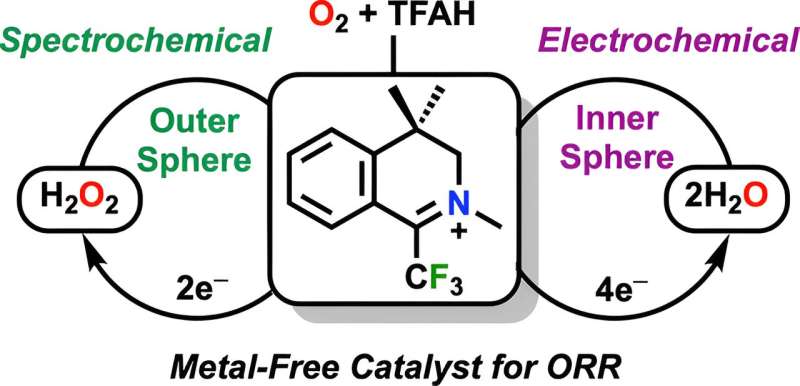Discovery of organic catalyst could lead to cheaper fuel cells

With atmospheric carbon dioxide at record highs, the search for clean-energy alternatives to the use of fossil fuels is growing increasingly urgent.
One obstacle that researchers face is that current fuel-cell technology relies on the use of expensive metal catalysts like platinum to convert hydrogen into energy; however, a team from the University of Virginia's College and Graduate School of Arts & Sciences has identified an organic molecule that could be an effective and less costly substitute for conventional metal catalysts.
The fuel cells that make electric vehicles and industrial and residential generators possible and that are needed to store energy generated by wind or the sun use metals like platinum to trigger the chemical reaction that splits fuel sources like hydrogen gas into protons and electrons that are then harnessed as electricity.
Until now, organic substitutes for rare-metal catalysts were not considered practical because the catalysis process causes them to break down into component parts that are no longer useful. In a paper published in the Journal of the American Chemical Society, however, associate professors of chemistry Charles Machan and Michael Hilinski, along with Ph.D. students Emma Cook and Anna Davis, identify an organic molecule composed of carbon, hydrogen, nitrogen and fluorine that has the potential to be a practical substitute.
The molecule can not only initiate the reduction of oxygen—the reaction that takes place inside the fuel cell—Machan said; it can continue to react with the products of the reaction and then revert to its original state.
"These molecules are stable under conditions in which most molecules degrade, and they continue to achieve activity that matches the level of transition-metal catalysts," Machan said.
The finding presents a significant step forward in the search for efficient fuel cells that use materials that are more sustainable and less costly to produce and could result in the development of the next generation of fuel cells within the next five to ten years, but the team's findings are just the beginning.
"This molecule itself may not make it into a fuel cell," Machan said. "What this finding says is that there can be carbon-based catalytic materials, and if you modify those with certain chemical groups, you can hope to turn them into great catalysts for the oxygen reduction reaction. The eventual goal is to integrate the properties that make this molecule so stable into a bulk material in order to supplant the use of platinum."
Hilinski, whose research group focuses on organic chemistry, emphasized the importance of the interdisciplinary nature of the research team. "This molecule that we use as a catalyst has a history in my laboratory, but we have always researched its use in chemical reactions that are performed on much larger, carbon-containing molecules—like the active ingredients in medicines," Hilinski said.
"Without Charlie Machan's expertise, I don't think we would have made the connection to fuel cell chemistry."
The discovery could also have implications for the industrial production of hydrogen peroxide, a household product that's also used in the production of paper and the treatment of wastewater.
"The process of making hydrogen peroxide is environmentally unfriendly and very energy intensive," Machan said. "It requires high-temperature steam reforming of methane to release the hydrogen used to generate it."
His team's findings could also improve the catalytic component of that process, which could have positive impacts on both industry and the environment as well as on water treatment technology.
Hilinski also pointed out that the discovery and the collaboration that led to it could have impacts that extend well beyond energy storage. "Big picture, one of the most exciting things about this study is that by electrifying the catalyst, we have changed the way it reacts. This is something unexpected that could also be useful for the synthesis of medicines, which my research group is eager to explore."
Machan, whose research group focuses on molecular electrochemistry, also credits the interdisciplinary nature of the research team for the discovery.
"Without Mike Hilinski's group's know-how in making stable organic molecules that can undergo the kind of reactions necessary, the work wouldn't have been possible. This unique, organic molecule enabled us to do something that normally only transition metals can do," Machan said.
More information: Emma N. Cook et al, Metal-Free Homogeneous O2 Reduction by an Iminium-Based Electrocatalyst, Journal of the American Chemical Society (2024). DOI: 10.1021/jacs.3c14549
Journal information: Journal of the American Chemical Society
Provided by University of Virginia Study identifies key ingredient for affordable fuel cell catalysts
No comments:
Post a Comment